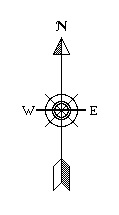Measuring the Earth's Magnetic Field

Instruments for measuring aspects of the Earth's magnetic field are among some of the oldest scientific instruments in existence. Magnetic instruments can be classified into two types.
- Mechanical Instruments - These are instruments that are mechanical in nature that usually measure the attitude (its direction or a component of its direction) of the magnetic field. The most common example of this type of instrument is the simple compass. The compass consists of nothing more than a small test magnet that is free to rotate in the horizontal plane. Because the positive pole of the test magnet is attracted to the Earth's negative magnetic pole and the negative pole of the test magnet is attracted to the Earth's positive magnetic pole, the test magnet will align itself along the horizontal direction of the Earth's magnetic field. Thus, it provides measurements of the declination of the magnetic field. The earliest known compass was invented by the Chinese no later than the first century A.D., and more likely as early as the second century B.C.
Although compasses are the most common type of mechanical device used to measure the horizontal attitude of the magnetic field, other devices have been devised to measure other components of the magnetic field. Most common among these are the dip needle and the torsion magnetometer. The dip needle, as its name implies, is used to measure the inclination of the magnetic field. The torsion magnetometer is a devise that can measure, through mechanical means, the strength of the vertical component of the magnetic field.
- Magnetometers - Magnetometers are instruments, usually operating non-mechanically, that are capable of measuring the strength, or a component of the strength, of the magnetic field. The first advances in designing these instruments were made during WWII when Fluxgate Magnetometers were developed for use in submarine detection. Since that time, several other magnetometer designs have been developed that include the Proton Precession and Alkali-Vapor magnetometers.
In the following discussion, we will describe only the fluxgate and the proton precession magnetometers, because they are the most commonly used magnetometers in exploration surveys.